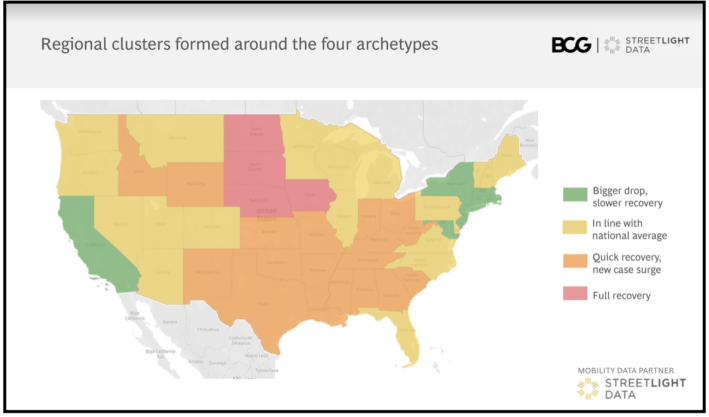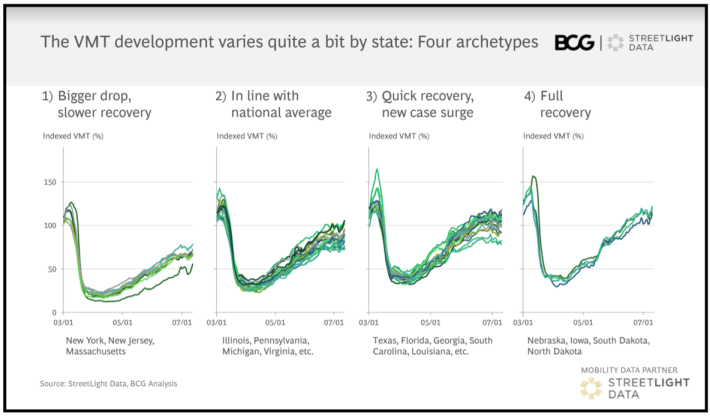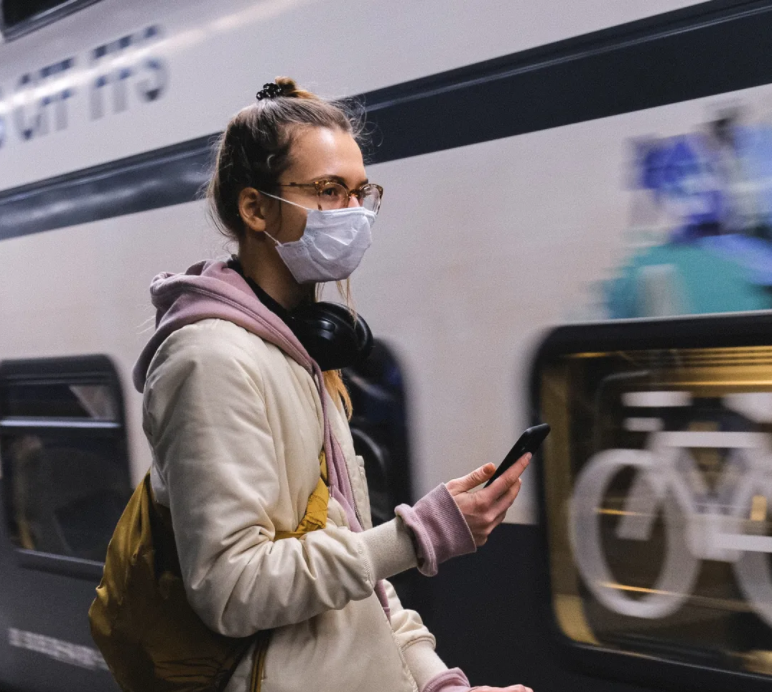U.S. car traffic has rebounded up to 90 percent of pre-pandemic levels in urban areas, a new study reveals — but cities with a higher proportion of wealthy residents who work from their living rooms have kept traffic volumes far lower than cities with more poor residents who have been forced to physically return to the workplace.
Researchers at the Boston Consulting Group and StreetLight Data pinpointed seven states that experienced steep drops in vehicle miles travelled, then managed to keep VMT low even as quarantines began to ease. But five of the seven states — California, Connecticut, Maryland, Massachusetts, and New Jersey — rank in the top 10 states in America for median income. The other two states — New York and Rhode Island — rank in the top 20.
Researchers also found a high correlation between a slow rise in post-lockdown VMTs and the prevalence of professional service jobs, as well as the high population density common to wealthy urban areas.


The new data support what many racial equity advocates have long suspected: that affluent Americans are seeing most of the benefits of the telework revolution — and that cities where rich Americans live are the ones reaping the most safety and emissions benefits of car-light roads.
About 37 percent of jobs can be performed entirely online, but those jobs are largely held by white workers who fall in the top 10 percent of nationwide earners, the researchers at Boston University observed. And the telework jobs that are held by people of color tend to be low-paying.
"On its own, further growth in telework will worsen social equity," the researchers noted.
And in non-COVID times, telework may not actually do much to cut carbon emissions, since wealthy remote workers tend to capitalize on the money and time they save on commuting by taking more unnecessary trips throughout the workday. Of course, working from "home" at a coffee shop across town is infrequent during the age of corona, but the researchers fear a newly expanded teleworkforce will return to its frequent-driving habit — and drive up emissions even more — once there's a vaccine.
But until that happens, America is still mired in an active pandemic — and perennial racial disparities in remote work are too often creating a stark national divide: comfortable quarantines for affluent white workers, contrasted with dangerous commutes for low-income people of color who are being forced back into their workplaces before the virus has been tamed.
"As we think about who's out there traveling right now, we're really talking about largely lower-paid essential workers," said Augustin Wegscheider of the Boston Consulting Group. "We're talking about healthcare workers, grocery workers, drivers of trains and buses and freight trucks — anyone who doesn’t have the freedom to decide not to travel right now. Simultaneously, this same group often doesn't have the luxury of being able to afford a private vehicle — so the folks who were already struggling to make ends meet now face a double conundrum, where they can’t really stop working, but the way they get to work might expose them to disease."
COVID-19 isn't the only danger faced by those with no choice but to return to a daily commute.
Through the pandemic, workers that depend on biking, walking, or driving to meet their commuting needs have been faced with stunningly dangerous road conditions — and saddled with government leaders who were far too reluctant to take action to curb the carnage. Roadway fatalities were up 23.5 percent nationwide in May compared to the previous year, despite steep drops in VMT and similar fatality increases in both April and March that should have demanded urgent, quick-build engineering changes to slow cars down. Experts are attributing the rise to the fact that wide, empty streets encourage speeding — and unless road design interventions are implemented, all that speeding increases crashes and fatalities, even with fewer cars on the road.
Transit-dependent workers, meanwhile, have been forced to contend with less-frequent routes and dangerous vehicle crowding borne from massive shortfalls in transit funding due to suppressed economic activity across the nation — a gap that Washington has been reluctant to close.
"Transportation has always been an essential ingredient to our economy — but during COVID-19, that's been ratcheted up to a whole new degree," said Laura Schewel, CEO at StreetLight. "We have a new and deepening understanding that transportation isn't just essential for the community to get to work; it’s a huge indicator of how well things are working for the American economy. ... Because when people stop moving, they pay fewer gas taxes, they pay fewer sales taxes, fewer everything. The road doesn't stop getting rained on just because fewer people are driving on it. We just need serious federal and state investment in transportation right now."
But where we choose to put our transportation dollars matters — especially if we want to keep essential employees safe on their commutes, while we work to expand social safety nets that might give more people the choice to stay at home, like expanding unemployment benefits, subsidized housing, nutrition assistance, and programs that expand access to better-paying telework jobs.
Experts say city leaders would be particularly wise to identify routes that are most heavily traveled by low-income workers, and prioritize those improvements and repairs — whether that involves adding a sidewalk along the shoulder, adding more frequent service to the bus route, or whatever else those road users need most. And during thin times, that might involve service cuts in other parts of the city where workers are more likely to be able to stay home.
"It sounds counterintuitive, but it's often not as equitable as it sounds to have a big, sprawling transit network that goes everywhere," said Wegscheider. "I think we need [public transportation providers] to go from, saying, 'I need to run a full network if I want to be equitable,' to saying, 'I need to run a really good service for the people who need it most.' We should double down where it really matters."
Until we start thinking holistically and strategically about all the ways to ease income inequality, car travel may continue to rise — and the most vulnerable groups in our society will continue to pay the price.






